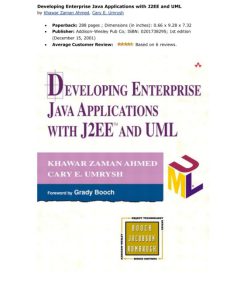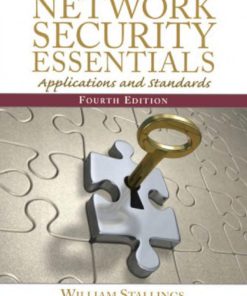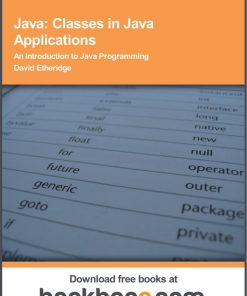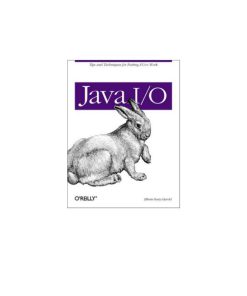Java Network Programming Developing Networked Applications 4th Edition by Elliotte Rusty Harold ISBN 1449365965 9781449365967
$50.00 Original price was: $50.00.$25.00Current price is: $25.00.
Authors:Elliotte Rusty Harold , Series:Computer Science [326] , Author sort:Harold, Elliotte Rusty , Ids:0596007213 , Languages:Languages:eng , Publisher:O’Reilly , Comments:Comments:Published October 2004, 706 pages.
Java Network Programming Developing Networked Applications 4th Edition by Elliotte Rusty Harold – Ebook PDF Instant Download/Delivery. 1449365965, 9781449365967
Full download Java Network Programming Developing Networked Applications 4th Edition after payment

Product details:
ISBN 10: 1449365965
ISBN 13: 9781449365967
Author: Elliotte Rusty Harold
This practical guide provides a complete introduction to developing network programs with Java. You’ll learn how to use Java’s network class library to quickly and easily accomplish common networking tasks such as writing multithreaded servers, encrypting communications, broadcasting to the local network, and posting data to server-side programs. Author Elliotte Rusty Harold provides complete working programs to illustrate the methods and classes he describes. This thoroughly revised fourth edition covers REST, SPDY, asynchronous I/O, and many other recent technologies. Explore protocols that underlie the Internet, such as TCP/IP and UDP/IP Learn how Java’s core I/O API handles network input and output Discover how the InetAddress class helps Java programs interact with DNS Locate, identify, and download network resources with Java’s URI and URL classes Dive deep into the HTTP protocol, including REST, HTTP headers, and cookies Write servers and network clients, using Java’s low-level socket classes Manage many connections at the same time with the nonblocking I/O.
Java Network Programming Developing Networked Applications 4th Table of contents:
Chapter 1. Basic Network Concepts
Networks
The Layers of a Network
The Host-to-Network Layer
The Internet Layer
The Transport Layer
The Application Layer
IP, TCP, and UDP
IP Addresses and Domain Names
Ports
The Internet
Internet Address Blocks
Network Address Translation
Firewalls
Proxy Servers
The Client/Server Model
Internet Standards
IETF RFCs
W3C Recommendations
Chapter 2. Streams
Output Streams
Input Streams
Marking and Resetting
Filter Streams
Chaining Filters Together
Buffered Streams
PrintStream
Data Streams
Readers and Writers
Writers
OutputStreamWriter
Readers
Filter Readers and Writers
PrintWriter
Chapter 3. Threads
Running Threads
Subclassing Thread
Implementing the Runnable Interface
Returning Information from a Thread
Race Conditions
Polling
Callbacks
Futures, Callables, and Executors
Synchronization
Synchronized Blocks
Synchronized Methods
Alternatives to Synchronization
Deadlock
Thread Scheduling
Priorities
Preemption
Thread Pools and Executors
Chapter 4. Internet Addresses
The InetAddress Class
Creating New InetAddress Objects
Getter Methods
Address Types
Testing Reachability
Object Methods
Inet4Address and Inet6Address
The NetworkInterface Class
Factory Methods
Getter Methods
Some Useful Programs
SpamCheck
Processing Web Server Logfiles
Chapter 5. URLs and URIs
URIs
URLs
Relative URLs
The URL Class
Creating New URLs
Retrieving Data from a URL
Splitting a URL into Pieces
Equality and Comparison
Conversion
The URI Class
Constructing a URI
The Parts of the URI
Resolving Relative URIs
Equality and Comparison
String Representations
x-www-form-urlencoded
URLEncoder
URLDecoder
Proxies
System Properties
The Proxy Class
The ProxySelector Class
Communicating with Server-Side Programs Through GET
Accessing Password-Protected Sites
The Authenticator Class
The PasswordAuthentication Class
The JPasswordField Class
Chapter 6. HTTP
The Protocol
Keep-Alive
HTTP Methods
The Request Body
Cookies
CookieManager
CookieStore
Chapter 7. URLConnections
Opening URLConnections
Reading Data from a Server
Reading the Header
Retrieving Specific Header Fields
Retrieving Arbitrary Header Fields
Caches
Web Cache for Java
Configuring the Connection
protected URL url
protected boolean connected
protected boolean allowUserInteraction
protected boolean doInput
protected boolean doOutput
protected boolean ifModifiedSince
protected boolean useCaches
Timeouts
Configuring the Client Request HTTP Header
Writing Data to a Server
Security Considerations for URLConnections
Guessing MIME Media Types
HttpURLConnection
The Request Method
Disconnecting from the Server
Handling Server Responses
Proxies
Streaming Mode
Chapter 8. Sockets for Clients
Using Sockets
Investigating Protocols with Telnet
Reading from Servers with Sockets
Writing to Servers with Sockets
Constructing and Connecting Sockets
Basic Constructors
Picking a Local Interface to Connect From
Constructing Without Connecting
Socket Addresses
Proxy Servers
Getting Information About a Socket
Closed or Connected?
toString()
Setting Socket Options
TCP_NODELAY
SO_LINGER
SO_TIMEOUT
SO_RCVBUF and SO_SNDBUF
SO_KEEPALIVE
OOBINLINE
SO_REUSEADDR
IP_TOS Class of Service
Socket Exceptions
Sockets in GUI Applications
Whois
A Network Client Library
Chapter 9. Sockets for Servers
Using ServerSockets
Serving Binary Data
Multithreaded Servers
Writing to Servers with Sockets
Closing Server Sockets
Logging
What to Log
How to Log
Constructing Server Sockets
Constructing Without Binding
Getting Information About a Server Socket
Socket Options
SO_TIMEOUT
SO_REUSEADDR
SO_RCVBUF
Class of Service
HTTP Servers
A Single-File Server
A Redirector
A Full-Fledged HTTP Server
Chapter 10. Secure Sockets
Secure Communications
Creating Secure Client Sockets
Choosing the Cipher Suites
Event Handlers
Session Management
Client Mode
Creating Secure Server Sockets
Configuring SSLServerSockets
Choosing the Cipher Suites
Session Management
Client Mode
Chapter 11. Nonblocking I/O
An Example Client
An Example Server
Buffers
Creating Buffers
Filling and Draining
Bulk Methods
Data Conversion
View Buffers
Compacting Buffers
Duplicating Buffers
Slicing Buffers
Marking and Resetting
Object Methods
Channels
SocketChannel
ServerSocketChannel
The Channels Class
Asynchronous Channels (Java 7)
Socket Options (Java 7)
Readiness Selection
The Selector Class
The SelectionKey Class
Chapter 12. UDP
The UDP Protocol
UDP Clients
UDP Servers
The DatagramPacket Class
The Constructors
The get Methods
The setter Methods
The DatagramSocket Class
The Constructors
Sending and Receiving Datagrams
Managing Connections
Socket Options
SO_TIMEOUT
SO_RCVBUF
SO_SNDBUF
SO_REUSEADDR
SO_BROADCAST
IP_TOS
Some Useful Applications
Simple UDP Clients
UDPServer
A UDP Echo Client
DatagramChannel
Using DatagramChannel
Chapter 13. IP Multicast
Multicasting
Multicast Addresses and Groups
Clients and Servers
Routers and Routing
Working with Multicast Sockets
The Constructors
Communicating with a Multicast Group
Two Simple Examples
People also search for Java Network Programming Developing Networked Applications 4th:
java network programming
java network programming pdf
java network programming 4th edition
java network programming elliotte rusty harold pdf
java network programming ppt
You may also like…
eBook PDF
Programming C Building NET Applications 4th Edition by Jesse Liberty 0596006993 9780596006990
eBook PDF
Programming C Building NET Applications 4th Edition by Jesse Liberty 0596006993 9780596006990
eBook PDF
Developing Mainframe Java Applications 1st Edition by Lou Marco ISBN 0471415286 978-0471415282












